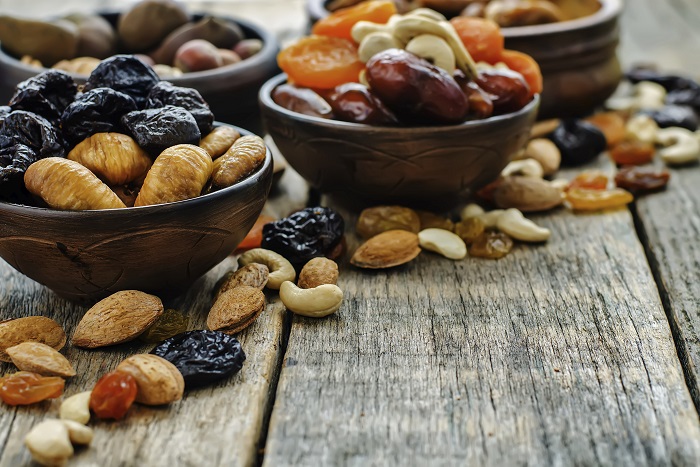
You may have heard of a Passover seder, but did you know that many people celebrate Tu BiShvat with ?
Jewish mystics in the 16th and 17th centuries created a special ritual, modeled after the Passover seder, which celebrated God’s presence in the natural world. As the rituals and readings for the Tu BiShvat seder developed, they were eventually collected into a book, "Pri Eitz Hadar," ("The Fruit of the Goodly Tree"), which was published in 1753.
But you don’t need to be a mystic to create your own Tu BiShvat seder!
You will need:
White and red grape juice or wine (enough for four small glasses per person)
A Tu BiShvat seder, full of imagery and symbolism, is often divided into four sections that represent the four seasons. As with the Passover seder, the Tu BiShvat seder evolved to include four cups of wine or grape juice, but in varying shades of red to represent the cycle of growth: white for the bleak winter, white with a bit of red to represent the earth’s awakening in early spring, red with a bit of white to represent the blossoming of late spring, and dark red to represent the fullness of growing plants and vegetation in the heat of summer.
For adult or older teen participants, the seder is sometimes also divided into four mystical “spheres,” each of which represents a different relationship between humans and the earth: Assiya (Actualization), Yetzira (Formation), Beriah (Creation), and Atzilut (Nobility).
Three categories of fruits or nuts:
- Those with an inedible outer covering and edible inside such as melons, nuts, pomegranates, coconuts, citrus, bananas, etc.
- Those with an edible outside but an inedible pit inside: dates, olives, plums, peaches, apples, avocados, nectarines, pears, etc.
- Those that are entirely edible: berries, figs, grapes, etc.
These categories are said to represent different seasons and/or ways of being in the world, often following kabbalistic categories.
Favorite readings, poems, quotes, pictures, or other sources about trees, nature, the environment, or anything else in our natural world.
Combine as desired, depending on the ages and interests of your participants! Here are some seder resources for you to check out and enjoy with your family or community:
A Tu BiShvat Seder Guide for Kids: Video discussion and activity guide for children and their parents. Appropriate for ages 4-7.
Tu Bishvat seder (Rabbi David J. Gelfand, Cantor Sarah J. Sager, Rabbi Billy Dreskin, and the Tu BiShvat Seder Production Team of Fairmount Temple in Beachwood, OH): Great short seder, could also be used as a template to create your own! Appropriate for ages 8+.
Shabbat Tu BiShvat seder (Temple Emanuel Sinai in Worcester, MA): A shorter seder that takes participants through the major rituals (four cups of wine/juice, four mystical spheres) and includes appropriate blessings for Shabbat (and the blessing after the meal). Great for kids 10 and up!
Environmental seder (Religious Action Center of Reform Judaism and NFTY: The Reform Jewish Youth Movement): Seder with a gentle emphasis on environmental justice. Includes four questions for Tu BiShvat, major rituals of four cups of wine/juice, explanations of the four spheres, and a good resource list at the end for more information and action suggestions. This is great for anyone who's 12 years old or older.
Israel-focused seder (World Zionist Organization): Hebrew and English seders (Hebrew version starts from the beginning of the document; English version begins from the end of the document) with a strong focus on Israel and its environmental issues. Suitable for audiences 12 and up.
Seder booklet (Rabbi Mark Hurvitz): Lovely shorter seder in booklet format, includes rituals for the four cups of wine/grape juice and readings relating different kinds of fruit to our different kinds of human relationships. This is a great resource for older teens and adults.

